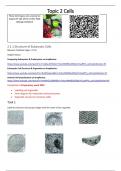Procaryotes - Study guides, Revision notes & Summaries
Looking for the best study guides, study notes and summaries about Procaryotes? On this page you'll find 20 study documents about Procaryotes.
Page 2 out of 20 results
Sort by
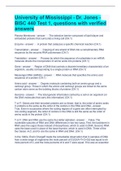
-
University of Mississippi - Dr. Jones - BISC 440 Test 1, questions with verified answers
- Exam (elaborations) • 11 pages • 2023
- Available in package deal
-
- £14.56
- + learn more
University of Mississippi - Dr. Jones - BISC 440 Test 1, questions with verified answers Plasma Membrane The selective barrier composed of lipid bilayer and embedded proteins that surrounds a living cell (CH.1) Enzyme A protein that catalyzes a specific chemical reaction (CH.1) Transcription Copying of one strand of DNA into a complimentary RNA sequence by the enzyme RNA polymerase (CH.1) Translation Process by which the sequence of nucleotides in an mRNA molecule direc...
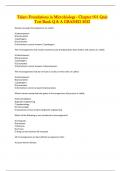
-
Talaro Foundations in Microbiology - Chapter 001 Quiz Test Bank Q & A GRADED 2023
- Exam (elaborations) • 4 pages • 2023
- Available in package deal
-
- £7.08
- + learn more
Talaro Foundations in Microbiology - Chapter 001 Quiz Test Bank Q & A GRADED 2023 Disease-causing microorganisms are called: A) decomposers B) procaryotes C) pathogens D) eucaryotes E) fermenters correct answers C) pathogens The microorganisms that recycle nutrients by by breaking down dead matter and wastes are called: A) decomposers B) procaryotes C) pathogens D) eucaryotes E) fermenters correct answers A) decomposers The microorganisms that do not have a nucleus in th...
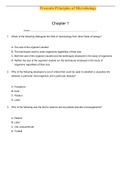
-
TEST BANK - Prescotts Principles of Microbiology
- Exam (elaborations) • 796 pages • 2022
-
- £20.07
- + learn more
1. Which of the following distinguish the field of microbiology from other fields of biology? A. The size of the organism studied B. The techniques used to study organisms regardless of their size C. Both the size of the organism studied and the techniques employed in the study of organisms D. Neither the size of the organism studied nor the techniques employed in the study of organisms regardless of their size 2. Who of the following developed a set of criteria that could be used to estab...

-
Micro Bio 120 Exam 1 Questions with Correct Answers 100% Solved
- Exam (elaborations) • 41 pages • 2024
-
- £8.10
- + learn more
Micro Bio 120 Exam 1 Questions with Correct Answers 100% Solved True or False: The plasma membrane and most other membranes are composed of a lipid bi-layer in which integral proteins are buried. True True or False: Procaryotic cells are usually smaller than eucaryotic cells. True True or False: Most procaryotes have strong cell walls that give them shape. True The significance of the plasma membrane is that: A) It selectively allows some molecules to pass into the organism ...
BRIEF DESCRIPTION OF THE WHOLE TOPIC WITH EXTRA NOTES AND QUESTIONS PROVIDED WITH ITS ANSWERS. MORE LINKS TO VARIOUS SITES TO UNDERSTAND THE PARTICULAR TOPIC.
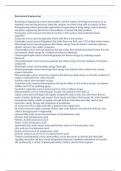
-
Biochemical Engineering
- Exam (elaborations) • 7 pages • 2023
-
- £12.59
- + learn more
Biochemical Engineering correct answersdeals with the conduct of biological processes on an industrial scale and the processes where the catalysts are either living cells or extracts of them Bioengineering correct answersthe application of engineering to living things, such as humans and plants. engineering that involves biosynthesis of animal and plant products Procaryotes correct answerscells that do not have a true nucleus; lack membrane bound organelles Eucaryotes correct answersorganisms...
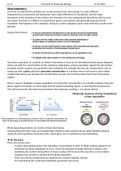
-
Phase Separation 2
- Lecture notes • 9 pages • 2022
-
- £7.25
- + learn more
Last time we said that the problem we are discussing is how cells manage to create different compartments; procaryotes and eukaryotes have major differences in complexity, and the major innovation in this transition is the nucleus, the invention of a new compartment that allows cells to carry out certain functions in a different compartment (gene transcription) and physically separated from translation that happens in the cytoplasm. Doing so, creates regulatory layers that otherwise would not be...

-
The Cell
- Lecture notes • 8 pages • 2022
- Available in package deal
-
- £2.58
- + learn more
this is the summary of ' The Cell' unit

-
TOUT SUR LA MICROBIOLOGIE
- Summary • 9 pages • 2021
-
- £5.90
- + learn more
Ce cours cible l'étude des microorganismes procaryotes et eucaryotes: leurs structures, mode de reproduction, physiologie et métabolisme sont comparés; leur distribution dans la nature et leurs relations avec les autres organismes vivants sont étudiés, en intégrant les concepts de symbiose et pathogénicité. Le cours cible aussi les stratégies mises en place pour la destruction et le contrôle des microorganismes. Un contexte plus écologique, la diversité microbienne des sols et les c...
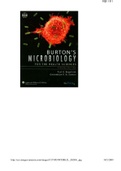
-
Burton's Microbiology for the Health Sciences 8th Edition_LATEST | Microbiology for the Health Sciences_2020
- Exam (elaborations) • 622 pages • 2021
-
- £13.77
- + learn more
Burton's Microbiology for the Health Sciences 8th Edition_Paul_G._Englekirk_Gwendolyn Microbiology: The Science Learning Objectives AFTER STUDYING THIS CHAPTER, YOU SHOULD BE ABLE TO: Define microbiology, pathogen, nonpathogen, and opportunistic pathogen List several reasons why microorganisms are important (e.g., as a source of antibiotics) Explain the relationship between microorganisms and infectious diseases Differentiate between infectious diseases and microbial into...

Study stress? For sellers on Stuvia, these are actually golden times. KA-CHING! Earn from your revision notes too and start uploading now. Discover all about earning on Stuvia

